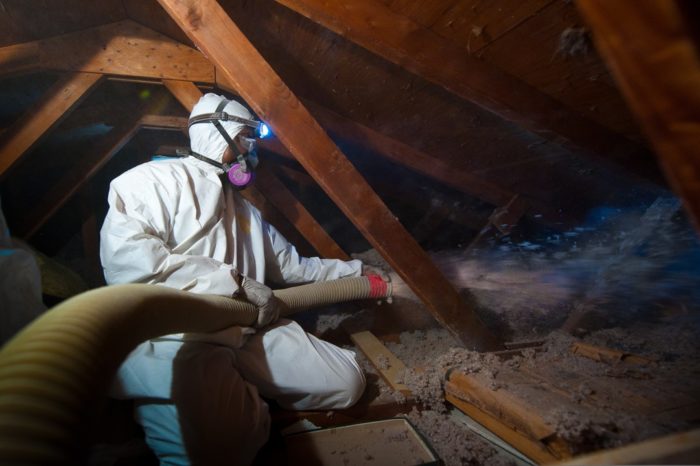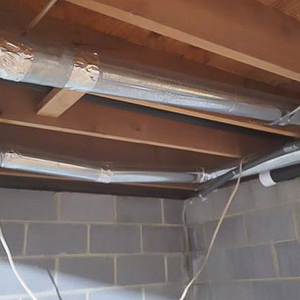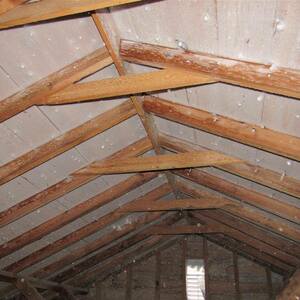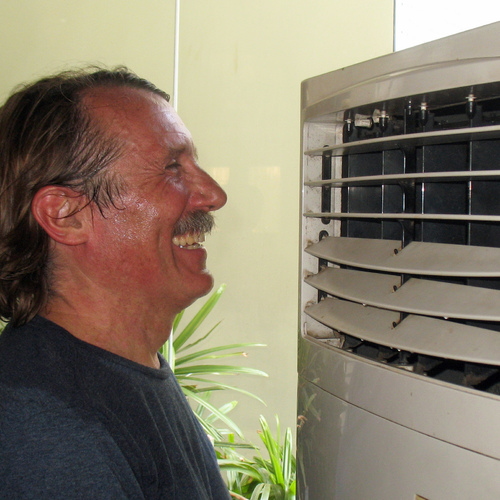
Image Credit: Dennis Schroeder/National Renewable Energy Laboratory
When Jeff Watson realized that the insulation on his attic floor was rated at R-11, he did what any energy professional would have suggested: he added more insulation. He air sealed the attic floor, added ventilation baffles where necessary, and blew in a thick layer of R-60 insulation. But he isn’t entirely satisfied at the results.
“As expected, the temperature in the house doesn’t fluctuate as much,” Watson writes in a Q&A post at GreenBuildingAdvisor. “However, I feel as if I’m using AC more.
“Before the R-60, the AC would be on when it’s 80+ degrees out,” Watson continues, “Now I’m using it even when it’s in the low 70s outside, because the house refuses to budge in temperature when I’m trying to air it out by cracking some windows open.”
For example, with the daytime outside temperature at 85°F, Watson’s air conditioner has cooled the interior to 78°F. At night, outside temperatures have dropped to 70°F, but after leaving windows open all night, the indoor temperature is still at about 79°F.
What’s up? Watson’s hunch is there isn’t enough attic ventilation. All the heat stored in the insulation filters into the house rather than venting to the outside. He has eight soffit vents and two “turtle vents” at the top of the roof, he reports, and he wonders whether he should maybe add some more.
Is he on the right track? That question is the topic for this Q&A Spotlight.
Attic ventilation is overrated
Judging by articles posted at GBA in the past, attic venting doesn’t accomplish much in the way of cooling, says Peter L. The main reason to install vents, he says, is to dry any moisture that accumulates on wood in the…
Weekly Newsletter
Get building science and energy efficiency advice, plus special offers, in your inbox.

This article is only available to GBA Prime Members
Sign up for a free trial and get instant access to this article as well as GBA’s complete library of premium articles and construction details.
Start Free TrialAlready a member? Log in















6 Comments
why no night flushing
it makes no sense to try to combine night flushing with daytime air conditioning
I do not understand this conclusion, at least in the context of a location with a decent diurnal swing. If you can reduce the temperature of the mass of the house by 5-10 degrees overnight, why is this not helpful? Obviously you do not want to run both systems at the same time, but I can't see the problem with running them in series.
I agree that if the climate is humid there is the question of removing latent heat. Without doing a calculation, I cannot estimate whether the latent outweighs the benefit of cooling the house's thermal mass. But that seems like it would only be a concern in a fairly humid climate, yet your advice suggests that you think it's a bad idea across the board. Why?
holding heat
Okay, I want to see the NREL study on the specific heat capacity
of girlfriends. Since it would invariably be tied to mass, the
followup study on eating disorders would probably be interesting...
Anyway, Dana set me straight a while back on the "capacity" of
most insulating materials, be they fluffy or polyiso or whatever.
It's not much. The structure and materials probably account for
a lot more "holding" than the blown-in. I thought I was seeing
temporal-lag effects through polyiso on unusually warm winter
days, but it turned out to be an illusion. A foot of brick,
maybe, but not layers of 'iso or 'glass. [How would something
like dense-pack cellulose weigh in here?]
I've found that it takes a *significant* delta between accumulated
interior temp and nighttime outdoor temp to be useful at all, and
only when windows are appropriately opened on different levels to
allow the little bit of available stack effect to actually move
air up through the house. But how much flow is that really from
the gentle drift, maybe 50 CFM all told [SWAG] if you've thrown
everything open? Say it went down ten degrees outside, you've got
50 * 1.08 * 10 sensible, all of 540 BTU/h you're expecting to actually
cool anything. Conductive loss that might have helped in the past is
down in the noise with the improved envelope! Now add the downside
that the night air probably got quite a bit more humid as the temp
dropped ... did you notice that mist on the car roof outside as
you were opening windows? Now you've let all that into your nice
dehumidified air-conditioned space, and have to get rid of all
that latent whenever the A/C next fires up.
So I only try any of this on cooler *dry* nights.
_H*
Cooling at Night
90's built CA ranch style house, R30 batts in ceiling, R19 in walls. Low solar gain due to good orientation of double pane windows and generous roof overhangs (porches). This article hits home and this is what I have done for 15 years to good effect. Thermostat is set @ 80 degrees all day. It is set @ 74 degrees at night. We like it cool at night for sleeping. I'd guess the KWH to be a wash, could be less, but it is no more for sure. If I choose a blocked time tier rate plan I could save some $$, but not enough to have to think about it. With the large drywall thermal mass being cooled overnite these are real world observations: 85 degree day the AC does not come on until 6 pm, 90 degree day 4 pm, 100 degree day 2 pm. It gets down to 60 degree a at night in CA but the humidity goes up.at night so window venting makes no sense. Have sealed the usual offenders in floor and ceiling planes and there is still enough natural infiltration to keep air quality good. In CA the daytime infiltration air is dry so it dehumidifies the house. Air in the house stays clean thanks to a high MERV in duct return air filter. My only complaint is the AC load calculation done on this house was wrong. The AC is about 25% oversized, all the more so since plugging attic leaks If we lived in FL would need to downsize it to address humidity. One day I'll upgrade the attic to cellulose (for winter heating) and see what happens.
CA air is generally pretty dry
When it's 60F overnight the outdoor dew points are probably in the mid-50s F or lower, which is just fine for using a night-ventilation strategy That air might be at a high relative humidity at 60F, but when you bring it indoors and raise it's temp into the 70s the RH will be under 60%, maybe even under 50%. The RH of fully saturated air on a 60F foggy night is only 59% when raised to 75F, which is below the mold-explosion threshold.
In much of the eastern half of the US the night-time outdoor dew points average in the mid-60s to low 70s F, which isn't that healthy at 75F indoor temps. When the pollen counts are low I'll open up windows to cool the house overnight when the predicted dew points are expected to be in the mid-50s or lower, but at 60F+ dew points I use mechanical dehumidification & air conditioning to manage the loads. (When pollen counts are high I keep the windows closed even at low outdoor dew points, due to allergy & asthma conditions among family members.)
Here is the explanation...
BAD DESIGN - A misunderstanding of the heat capacity and moisture storage content(an electrically charged material that attracts moisture which causes it to expand at the surface, store and release moisture based on RH) and their ability to breathe. Has less to do with dew point, temp, attic insulation, etc...more to do with dynamic material properties (specific heat, density, thickness) design that most do not understand...to begin to understand that you have to understand the valuation and difference between dynamic mass and steady state r-value.
Synthetic manufactured gypsum is a bad choice, most concretes with high levels of portland cement as the binder is another. Neither have much useful mass, high heat-cool storage capacity, or the ability to expand-store when wet, shrink when dry...you can not force these materials to perform in ways they are not design for by changing the environment they are placed in.....wrong approach!
Hempcrete, limecrete, and especially earthcrete with the right types of clay are much better than OPC_concrete. Better IAQ and for the environment too. You won't find much complaining like this from these homeowners, house stays cool in summer, warm in winter, little heat-cool loads, no humidity control required.....allergy problems solved, no mold and mildew.
Knowing where to place mass is the other challenge, as are the building permits, getting labor cost down, the chemistry is a big challenge.
Reduced load and latent heat
It seems a discussion of sizing is largely missing here. My humid summer bias will show here, though.
Adding attic insulation and air sealing can reduce cooling loads by 1/2-1 ton fairly often, making what is likely already an oversized AC even bigger. If it short cycles, which it should with little load, any vents at the end of the runs, often on a second floor (if the house has one) don't get as much latent (water heat) or sensible (air heat) removal. This leaves them uncomfortable.
Ironically, after spending money on insulation to save energy and be more comfortable, it may be a good idea to buy a smaller AC. If the homeowner prefers higher temperatures and it is not the primary heat source, undersize it a bit, too. This will do a really good job at latent removal because it runs a lot. Considering a heat pump upgrade could be smart, too, since it will heat well at higher temperatures that have low loads.
I also wonder if the building materials are getting warm (the thermal mass) and the night time open windows technique is not removing the heat well from them. Setting it and forgetting it with a smaller AC could help leach heat and moisture out of the materials day and night and lead to better mean radiant temperatures.
This is one of the dangers of prescriptive upgrades, they often cause other unforeseen problems. A thoughtful upgrade design could have avoided this.
Just some musings...
Log in or become a member to post a comment.
Sign up Log in